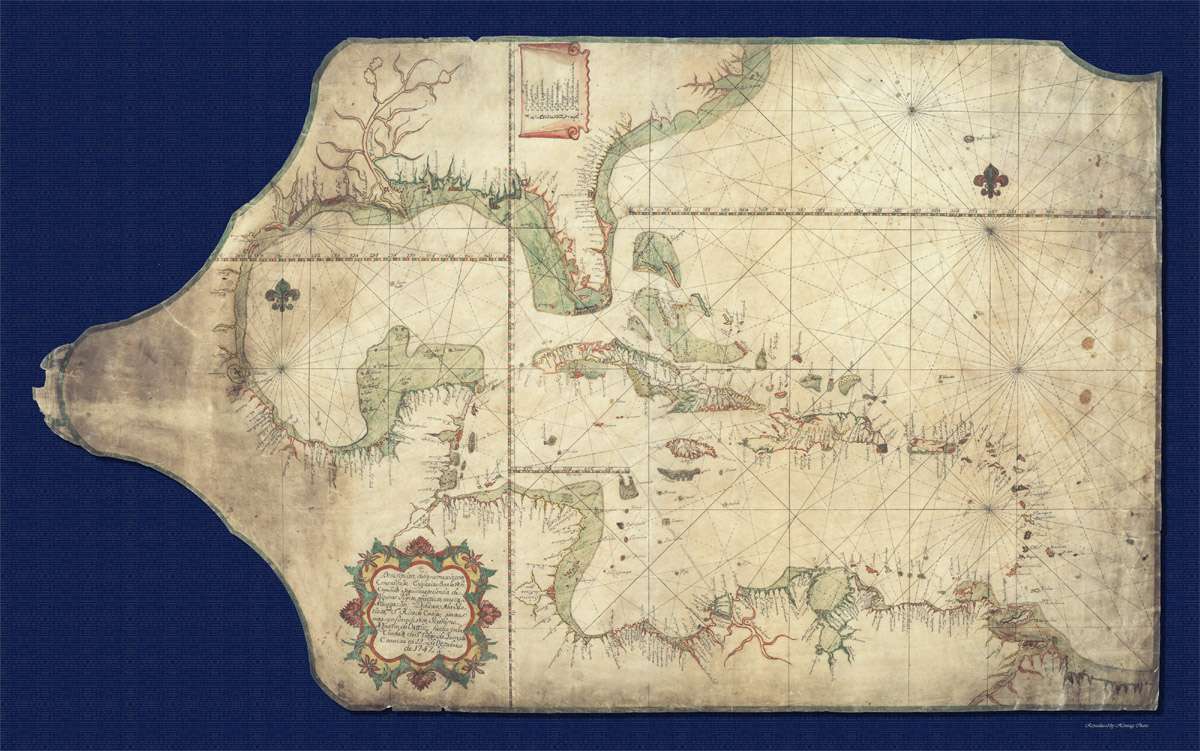A730 - Spanish portolan chart of the Gulf of Mexico and the Caribbean Sea
Although clearly a late example of a portolan chart this delightful manuscript shares all of the characteristics of pre 16th century charts.
- 1748
- Geronimo Augustin de Orttuz
- h27.5" x w43.5"
- L
The title cartouche on this beautiful chart reads more or less as follows: 'Description of the gulf of Mexico with its surrounding area, Information on Windward Isles collected with the experience of some skilled navigators in this nautical area. Dedicated to the Most Glorious Santa. Rita de Casia by your most devoted Geronimo Augustin de Orttuz, made in the city of Santiago de Leon de Caracas on October 12, 1747'.
Santa. Rita de Cascia to whom this chart is apparently dedicated was a 16th century nun who is the patroness of Impossible Cases (nice one Geronimo!).
Portolan charts were navigational maps based on compass directions usually utilising estimated distances observed by the pilots at sea. The information they contained was very valuable, especially at the outset of the age of discovery with the charts themselves often being treated like State secrets.
Invariably drawn on sheep skin the word 'portolan' is derived from the Italian adjective 'portolan' which means 'related to ports or harbors'. This is especially relevant as the 'loxodromic' or 'rhumb' lines which criss-cross the chart represent the thirty-two directions (or headings) of the mariner's compass from a given point. The lines themselves are used to point the way to ports and harbors drawn and named on the chart. The major draw-back with Portolans and loxodromic or rhumb lines was that they failed to take into account the curvature of the earth and as a result, they were of little use as navigational tools when crossing the open ocean.
All of the major sand-banks around the coasts are marked and although the chart covers a huge area it may still have been relatively effective considering the multitude of land falls of the Caribbean. The multitude of ports, harbors and town marked along the coastline of the mainland from as far north as Virginia, down around the Florida peninsular into the Gulf of Mexico and the northern coast of South America is testament to the incredible amount of 'previous knowledge' that had been brought to the making of this chart.
It is not just the settlements which impress but also knowledge of inland river ways such as the Mississippi. The labelling of the major ports and settlements along the mainland American coastline are inverted around the charts so that it may easily be read people looking at it from all sides around the table. It is well worth noting the stylistic longitude and latitude scales which are interwoven into the chart. The longitude measures are remarkably accurate although the latitude key is clearly referenced from a point other than London.
Two major forts and noted on the chart, one on the Island of New Orleans and the other at Apalache(e) near present day Port Leon. It is possibly the original wooden stockade built here by the Spanish in 1680. The chart also includes a key at the top of the chart which names each of the Florida Keys.
Of further note is the color on this chart which is especially vibrant considering the age of the original manuscript. The use of color is intriguing however as it does not seem to be used to delineate ownership of sovereignty but rather to be applied randomly. Perhaps the different colors refer to especially difficult parts of the coastlines, relatively safe or navigable stretches or even unmapped stretches. The only obvious consistency is that all shoals or sandbanks are colored green.
The use of standardised hydrographical symbols for rocks or reefs and sandbanks shows the extent to which such information was universal even at this time.
- Spanish portolan chart of the Gulf of Mexico and the Caribbean Sea


